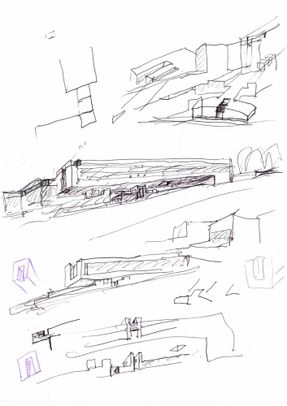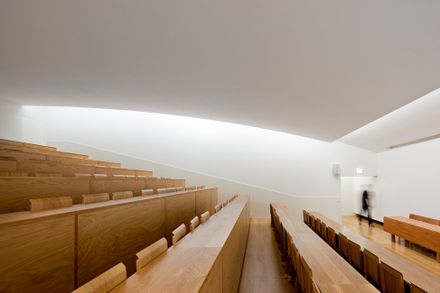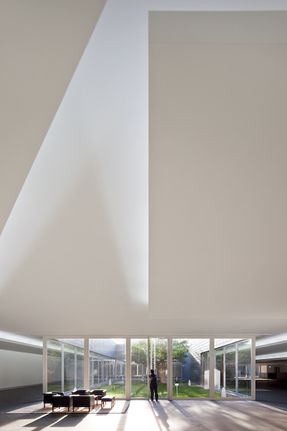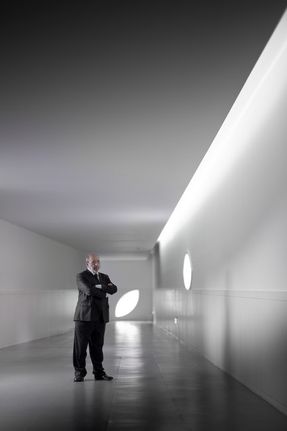Amore Pacific Research & Design Center
AMORE PACIFIC RESEARCH & DESIGN CENTER
Alvaro Siza, Carlos Castanheira and Kim Jong Kyu
ARCHITECTS
Alvaro Siza, Carlos Castanheira and Kim Jong Kyu
MANUFACTURERS
Kvadrat Soft Cells
LOCATION
Yongin-Si, South Korea
CATEGORY
Research Center
Amore Pacific is a brand of cosmetics, products used in industrial quantities by oriental women to enhance their beauty, hide imperfections or to deepen the whiteness of their skin, a sign of nobility and beauty, like the gaja (The Portuguese word from which the Japanese word “geisha” originates) whose white features, charm and musical sensibility turned her into an object of cult and desire.
The first introduction that resulted in work in Korea, (the southern half, that is, since for many Koreans there is only one Korea, temporarily subdivided), coincided with the visit to Portugal by the owner of Amore Pacific, for the purpose of getting to know Álvaro Siza’s work.
As I knew the architects who accompanied with him, it was my job to show them around. His intention was to formalise an invitation to design a museum.
Initiated by his grandmother, the cosmetics company had almost by chance begun to collect items related to the wellbeing of women. Cosmetic items, clothing items, decorative items as well as items relating to the tea ceremony.
Today, the collection is immense, as are also the quality and the beauty of most of the items. Items of national value and interest, concerning things for which quantity also is quality.
Enthused, the client wants to locate the museum in the centre of the city of Seoul, and so purchases more and more land, something which is so scarce on those shores and expensive, very expensive.
Forty minutes drive from Seoul, in the outlying city of Yongin-si, Gyeonggi-do, Amore Pacific has a very large estate, which I like to call a campus, as that is what it seems like. In this campus are gathered the R&D – Research and Development, and the training departments.
There is a large grey granite building, where the research and investigation laboratories are concentrated. This building is the result of various additions and adaptations. And now it urgently needs major restructuring.
In another dark brick building are all the staff training facilities and the improvised museum, displaying only a small part of the collection. The rest of the ever-expanding collection is in storage, in the basement.
Another small building, which is isolated, as if pushed into a corner, to the northeast, serves as accommodation for anyone who comes here from a distance to do training or research.
The exterior area is characterised by a huge collection of trees and shrubs that the client buys or transplants here from elsewhere.
In Korea everything gets transplanted. From the huge, sculptural pine tree, that we are used to seeing in oriental prints, to the most subtle maples in varying colours.
The transplants, set in groups, seem more like art installations: the trees linked together with thick bamboo canes, supporting each other until they develop roots.
The huge sports fields that still give sense to the maxima mens sana in corpore sano, are now abandoned in preference for the health club.
At the start of the project the Laboratory was envisaged in the space next to the existing one, allowing most of the services to be moved and for the desired re-use of the old equipment.
The short term need to include a new building for more laboratories would have to be considered, in the normal and predictable expansion process.
Then came the Pavilion, a multi-use space linking buildings and functions. And the respective outside spaces, extensive, generous.
Next came the hotel, exclusively for private use to substitute the existing buildings which didn’t provide for the dignified reception of guests.
After the presentation of the sketch designs, another pavilion was requested. So, Pavilion II appeared.
While we are at it, it would be convenient to re-think the Gate House as it is the front of the Campus, of the Company.
And why not re-think the outside spaces, now that the relationship between the existing buildings and the planned ones has become so obvious?
A Campus is actually this, a relationship between buildings, where the external spaces act as a support. Or is it the other way around?






















































